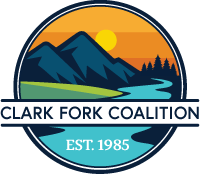
Cattle and Clean Water at Dry Cottonwood Creek Ranch
From 2005 to 2021, Clark Fork Coalition and partners ran Dry Cottonwood Creek Ranch (DCCR), a 2,300-acre working cattle ranch in Montana’s Deer Lodge Valley, to be a living classroom for the largest river repair job in the West, located in the heart of the largest Superfund complex in the nation.
As part-owner and the managing partner of DCCR, our goal was to showcase the challenges and opportunities involved in large-scale cleanup and restoration on a working ranch in the Upper Clark Fork watershed. Our promise was to serve as a “guinea pig” to work through the ins and outs of this unprecedented river transformation as it unfolded in the heart of cattle country, helping to demystify cleanup for other landowners next in line. While cleanup progressed, we produced beef for sale and crops to feed cattle, while also putting in place conservation projects to improve the range, the river and its tributaries, and our bottom line.
In 2018, thanks to financial support from the Natural Resource Damage Program, we purchased the adjacent Deer Lodge River Ranch, and then united the two ranches through easements that protect conservation investments made in the river bottom and the uplands. Those easement also provide permanent public access for the recreating public. As part of this purchase, our conservation partners set aside five acres and a small ranch house for CFC to run as a research, community, and education hub. Building on input from Deer Lodge Valley community members, this became the new Dry Cottonwood Field Center with surrounding acreage, meeting space, upgraded technology and WiFi, a new trail to the river, and other amenities.
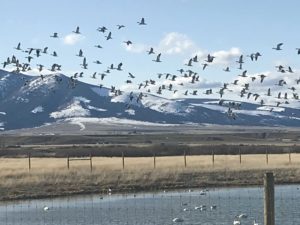
Superfund cleanup wrapped up at Dry Cottonwood Creek Ranch in 2016. In 2021 a Montana ranching family purchased the ranch, now combined with the adjoining property. Proceeds of the sale were returned to the Natural Resource Damage Program’s restoration fund.
A lot happened during our 16 years at Dry Cottonwood Creek Ranch! In that time, we modernized irrigation and ranching infrastructure, restored and protected four and a half miles of river, freed up 16 cfs of water to increase flow in the Clark Fork, reconnected two creeks to the mainstem river, opened up migration pathways to help native trout reach spawning grounds and cool headwaters refuge, installed fish screens to keep fish out of ditches, reduced sediment loads reaching Dry Cottonwood Creek, created new wetlands, improved river bottom and uplands habitats for diverse fish and wildlife species, and more.
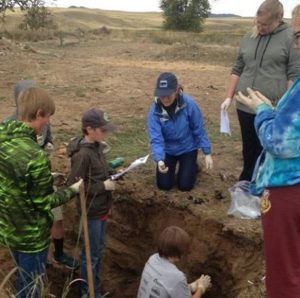
Though Superfund cleanup is a wrap on this stretch of river and the ranch is sold, we’re still deeply engaged in this story, learning every day what the river has to teach us about restoration and recovery. (Meanwhile, cleanup is underway on other stretches of the river.) We continue to partner with Montana universities on habitat, water quality, and other research in the river and its floodplain. We are tracking the river’s response to cleanup and sharing data with cleanup agencies to help improve cleanup designs on other reaches of the river. We’re working to ensure local communities are informed about and engaged in cleanup and restoration. And we’re collaborating with local educators to use this unique outdoor classroom to teach STEM concepts and engage youth in the transformation of their hometown river. Stay tuned: this amazing river recovery story is far from over!
Where did the toxic waste come from, and how is it being removed?
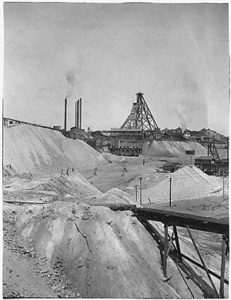
In 1908, a historic flood—the largest recorded flood in the basin’s history—transported mountains of copper mine tailings downstream from Butte. This, combined with subsequent flood events, deposited toxic pollution along 120 miles of agricultural floodplains in the headwaters of the Clark Fork River. The contaminated areas left behind—nicknamed “slickens” by the local ranchers—are devoid of plants, unproductive as agricultural lands, and harmful to aquatic life. In some places these slickens, which contain heavy metals such as copper and arsenic, are more than 10 feet deep, and they continue to erode into the river where they degrade water quality and poison fish.
More than a century after the 1908 flood, the Upper Clark Fork River Superfund cleanup is finally removing those toxic sediments from the floodplain along a 45-mile stretch of river. This cleanup is unprecedented in scope or scale. Over $100 million will be spent repairing the river, removing mining waste, and restoring tributary streams.
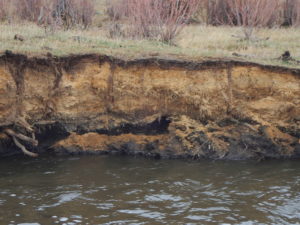
The project takes place primarily on private ranches, which is why the Coalition originally purchased DCCR. We volunteered to be first in line for the cleanup to share with our neighbors the challenges and opportunities in store for a working cattle ranch. The goal was to ensure the best possible cleanup and restoration for the river, and to encourage our neighbors to do the same on their properties.
We worked closely with scientists, nearby ranchers, and state agencies to devise a cleanup plan that minimized disturbance to agricultural activities while maximizing the benefit to the river. Cleanup on DCCR started in 2014 and finished up in 2016. The river is beginning to heal, but we still have a lot to learn about this complex process and how the river, floodplain, and riparian and aquatic habitats are responding.
Restoring flow and function to Upper Clark Fork creeks
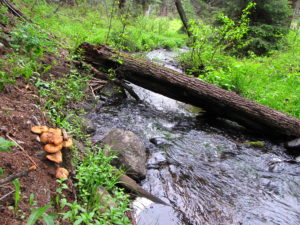
Removing mine waste from the floodplain is essential to the healing of the Clark Fork. But cleanup alone will not restore this river system. That’s why, since 2011, we have worked with a wide range of groups to ensure the cleanup of the mainstem river is accompanied by habitat restoration projects on tributary streams. In particular, we work closely with the Watershed Restoration Coalition, a landowner-led group based in the Deer Lodge Valley, on conservation projects that restore riparian corridors, remove barriers to fish passage, reconnect streams to the river, and re-water sections where flows are too low to support fish.
The Upper Clark Fork is a very thirsty river: Montana Dept. of Fish, Wildlife and Parks categorizes 87 miles of the river as dewatered. Dry years create havoc for agricultural operators, as well as fish and wildlife.
Water conservation projects proactively address the problems created by low flows. Since 2010, we’ve modeled several types of irrigation efficiency and water leasing projects that keep water in the creeks and rivers when fish need it most, and improve the reliability of water delivery to crops and livestock, too.
